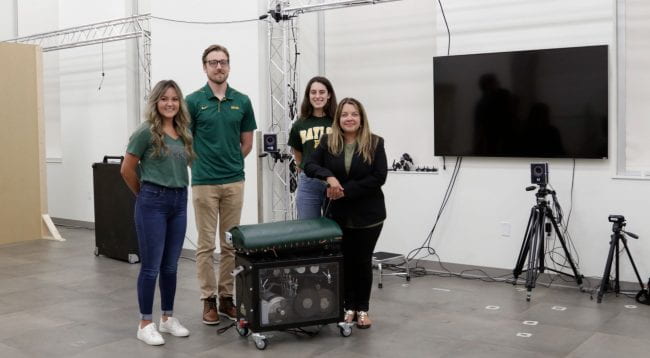
The SOE autism research team in the BRIC MiraColt lab (l-r): Ashley Allison, Ryan Coleman, Alex Plank, and Dr. Julie Ivey.
A team of Baylor School of Education autism researchers is helping evaluate the effectiveness of a Baylor-invented mechanical horse that is designed to treat children with autism. A Baylor interdisciplinary team received a grant of nearly $600,000 from the Texas Higher Education Coordinating Board to study the effectiveness of the MiraColt, a mechanical device that simulates the motion of horseback riding.
Dr. Julie Ivey, Associate Professor of Educational Psychology, is a co-investigator and is leading an SOE research team that includes one Ph.D. level School Psychology student, Ryan Coleman, and two Ed.S. level School Psychology students, Ashley Allison and Alex Plank.
The team is currently recruiting children ages 6-12 to participate in the project to measure the effects of riding the MiraColt, an invention patented by Baylor mechanical engineering Associate Professor Dr. Brian Garner. Through Baylor’s Lab To Market Collaborative, Garner formed Chariot Innovations, LLC, to develop and market the product.
Ivey and the SOE team are conducting behavioral and language assessments on participants for the project, located in a lab at the Baylor Research and Innovation Collaborative (BRIC). The lab includes mechanical systems to measure gait, balance, muscle coordination, speech, and brain wave activity using EEG helmets.
Ivey and the SOE team work one-on-one with the children and conduct assessments of behavior and language — pre-intervention, mid-intervention, and post-intervention. While the child rides the MiraColt, Ivey and the interdisciplinary team, including graduate students from across disciplines, guide the child to complete cognitive and motor activities, such as puzzles and games.
Ivey said that interventions using horses are believed to stimulate neurological connections because of the complex, three-dimensional motions of the horse that the child must respond to. She has previously published studies in collaboration with Dr. Beth Lanning in Baylor’s Department of Public Health to study the use of equine movement as an intervention for autism.
“Equine intervention can improve social and motor skills, as well as behavioral issues,” Ivey said. “However, not everyone has access to a horseback riding facility. Riding access could also be affected by bad weather and be largely unavailable for months at a time in some locations. The benefit of a mechanical horse for intervention is that it could provide help in a clinical setting with professionals who are trained to work with children with autism.”
The Baylor team is currently recruiting participants for the study, which will run until May of 2022. To qualify, children must be age 6-12, have a diagnosis of Autism Spectrum Disorder, experience motor deficiencies, and be able to follow verbal instructions. Parents will bring children to two sessions per week for 15 weeks at the BRIC, located at 100 Research Parkway in Waco. When they complete the study, participants will receive $150. Families can contact Julie_Ivey@baylor.edu for more information.
Ivey said that, even though the lab may be an unfamiliar setting for the children, she wants to assure families that the members of the interdisciplinary team have extensive experience working with children with autism and will help them adjust to a new environment. Ivey is a Licensed Specialist in School Psychology and founder of the Baylor Autism Resource Clinic.
While the study is in the early stages, Ivey said that preliminary observations are promising. “One participant’s mother said her child seemed ‘more in control and calm’ after several sessions,” she said. “And another parent reported her child showed some behavioral improvement in school related to communication and social interaction.”
The Baylor interdisciplinary team:
- Brian Garner, Ph.D., Associate Professor of Mechanical Engineering
School of Engineering and Computer Science - Julie Ivey, Ph.D., Associate Professor of Educational Psychology, School Psychology Program,
School of Education - Beth Lanning, Ph.D., Professor of Public Health
Robbins College of Health and Human Sciences - Jonathan Rylander, Ph.D., Assistant Professor of Mechanical Engineering
School of Engineering and Computer Science - Paul Fillmore, Ph.D., Assistant Professor of Communication Sciences and Disorders
Robbins College of Health and Human Sciences
Click to watch how the MiraColt works:
ABOUT BAYLOR SCHOOL OF EDUCATION
For more than 100 years, Baylor educators have carried the mission and practices of the School of Education to classrooms and beyond as teachers, leaders in K12 and higher education, psychologists, academics/scholars and more. With more than 50 full-time faculty members, the school’s growing research portfolio complements its long-standing commitment to excellence in teaching and student mentoring. Baylor’s undergraduate program in teacher education has earned national distinction for innovative partnerships with local schools that provide future teachers deep clinical preparation, while graduate programs culminating in both the Ed.D. and Ph.D. prepare outstanding leaders, teachers and clinicians through an intentional blend of theory and practice. Visit www.baylor.edu/SOE to learn more.
ABOUT BAYLOR UNIVERSITY
Baylor University is a private Christian University and a nationally ranked research institution. The University provides a vibrant campus community for more than 19,000 students by blending interdisciplinary research with an international reputation for educational excellence and a faculty commitment to teaching and scholarship. Chartered in 1845 by the Republic of Texas through the efforts of Baptist pioneers, Baylor is the oldest continually operating University in Texas. Located in Waco, Baylor welcomes students from all 50 states and more than 90 countries to study a broad range of degrees among its 12 nationally recognized academic divisions.
